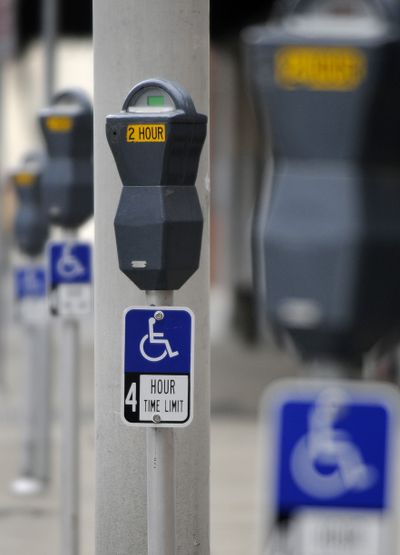New parking signs confuse some motorists

In trying to alleviate one parking problem in downtown Spokane, the city has created another: confusion.
New signs limiting disabled parking to four hours near the Fox, Bing Crosby Theater and Knitting Factory have left regular parkers baffled about whether they can park at meters in the area or not.
Every meter in the three-block area has a new sign showing the universal blue wheelchair symbol and the 4-hour time limit underneath. It means that disabled motorists, who can park at meters for free, can use the spaces for only four hours at a time. The signs went up last week in an effort to open up larger blocks of meter space for equipment trucks and tour buses coming to the three theaters.
The confusion caused Frank Sieh, a visitor from Vancouver, Wash., to be late.
He said he arrived in the area for a noon lunch Thursday and was initially hesitant to park because of the signs, so he drove around the posted area several times before making a decision “to take a chance.”
He wasn’t the only one confused. One pedestrian stopped meter reader Jerry Halladay Thursday and asked him what the new signs meant. “Everybody is asking about it,” Halladay said.
Larry Quiroga, manager at Carr Electric Supply Co., 919 W. First Ave., said his customers are telling him they think the signs mean that all of the meters are reserved for disabled parking only. “We’ve had a few people call back here in frustration,” he said.
People are conditioned to interpret the blue wheelchair symbol as a restricted space for disabled parkers only, not as a limitation on how long those motorists can use the space, he explained.
Dave Shaw, the city’s traffic control supervisor, said disabled parkers sometimes were leaving their vehicles for extended periods in places needed for moving trucks as well as buses or vendors that might be coming to various shows.
However, there are currently only a handful of disabled parkers using the area, he acknowledged.
One of them is a downtown resident who lives in an apartment in the area, and others are employees at adjacent businesses.
Managers of the entertainment venues can create temporary loading zones by putting meter bags over the meters in the slots they need for a show. The problem was that disabled drivers weren’t moving in time for the show, and semi-trucks sometimes double-parked in travel lanes, Shaw said.
The problem was studied by a committee of downtown business interests, and with the city, the committee came up with the idea of creating a new Entertainment Parking District and limiting disabled parking within the district to four hours, which is legal under state law. If the vehicles don’t move within four hours after a meter is “bagged,” they can be towed.
But now, disabled employees are forced to move their vehicles at least once during an eight-hour work shift, a chore that for some involves loading and unloading a wheel chair. Shaw said the city had received calls from at least two disabled workers.
Matt Judge, general manager at the Knitting Factory, said the parking problems needed to be addressed to make sure the city’s emerging entertainment district is successful. “For me, it’s more about providing a place for the artist,” he said.
He said his concert venue pays about $12,000 a year in fees to create the temporary loading zones needed for larger vehicles.
Ann Deasy, spokeswoman for the city’s street department, said the city has received a lot of calls from confused residents, but there were no plans yet to clear up the confusion.